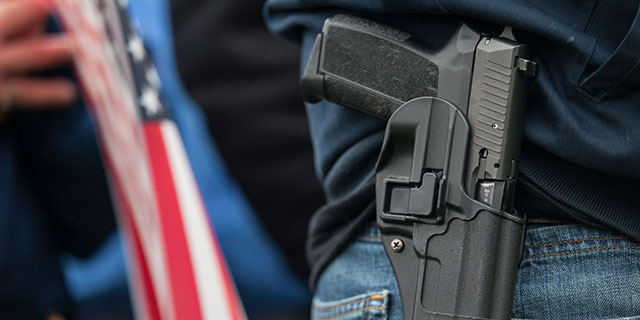
The higher percentage of enslaved people that a U.S. county counted among its residents in 1860, the more guns its residents have in the present, according to a new analysis by researchers exploring why Americans’ feelings about guns differ so much from people around the globe.
More than 45% of the world’s civilian-owned firearms are in the United States, where just 5 percent of the world’s people live. This disparity may have something to do with the way the majority of American gun owners view gun ownership.
“Gun culture is one case where American Exceptionalism really is true,” says Nick Buttrick, a University of Wisconsin–Madison professor of psychology. “We are really radically different even from countries like Canada or Australia, places that have similar cultural roots.”
Pew Research Center surveys show two-thirds of Americans who own guns say it’s a way to keep themselves safe, while in other countries, people are more likely believe the presence of a gun adds risk and danger to their lives, considering, for example, the far higher rates of homicide and suicide in households with guns. Gun culture scholars have also explored the role of race in American gun attitudes for some time, Buttrick says, and the two may be linked.
In a study published recently in the journal PNAS Nexus, Buttrick and co-author Jessica Mazen, a psychology graduate student at the University of Virginia, describe a shift in sentiment away from the predominant, pre-Civil War idea of guns as tools for hunting and sport. In the post-Civil War South, the belief that a gun was necessary to protect family, property and a way of life grew prominent among white southerners. This was driven by a flood of surplus military weapons, the rise of armed, white-supremacist organizations like the Ku Klux Klan, and elite rhetoric that Reconstruction governments would not protect the interests of white southerners from newly freed and politically-empowered Black people.
The researchers compared county-level population data from the 1860 census to gun ownership patterns in the present. Because there is no national record of gun ownership, the study uses a widely accepted proxy — the proportion of suicides in a county that involved a firearm, according to Centers for Disease Control and Prevention mortality records from 1999 to 2016.
“What we see is a strong correlation between the number of slaves in a county in 1860 and the number of guns there now, even after we control for variables like personal politics, crime rates, and education and income,” says Buttrick, who produced the study while working as a postdoctoral researcher at Princeton University, before joining the UW–Madison faculty this year.
This correlation was strong even when the researchers focused only on white gun owners, narrowing their proxy for gun ownership to firearm suicides involving only non-Hispanic white victims.
The study further pinpoints a particularly Southern root for the American belief that guns keep people safe.
“The extent to which people feel unsafe only predicts gun ownership in counties in the South, where the more unsafe people feel, the more likely they are to own a gun,” Buttrick says. “If you look in areas that didn’t have any slaves in the 1860s, whether people feel unsafe there today does not predict today’s county-level gun ownership.”
Additionally, areas in the North and West with more guns in the present day are home to people that are more likely to have Facebook friends that live in parts of the South that had higher historical rates of slavery. In these areas, as in the South, feeling unsafe is more likely to predict increased gun ownership. The researchers say this suggests that social transmission of beliefs about guns is at work.
“The question is, how do these ideas about guns get to the rest of the country?” Buttrick says. “As people move, they bring with them the culture that formed them. We can see the remnants of those moves and the lingering connections to family and community in people’s social media connections, and it lines up with the slavery-gun-ownership pattern.”
The results may give researchers a clearer sense of how gun culture has developed and evolved differently across the country – why some parts of the country still retain a hunting culture, while others are dominated by a gun culture based around personal protection.
“It helps to elucidate some things — why is it that race and guns are so tightly tied together? Why is it that guns are so present in the public mind and discussion for white people and not for Black people?” Buttrick says. “And it does help make sense of why protective gun ownership is such a popular idea in the United States, but not elsewhere.”

